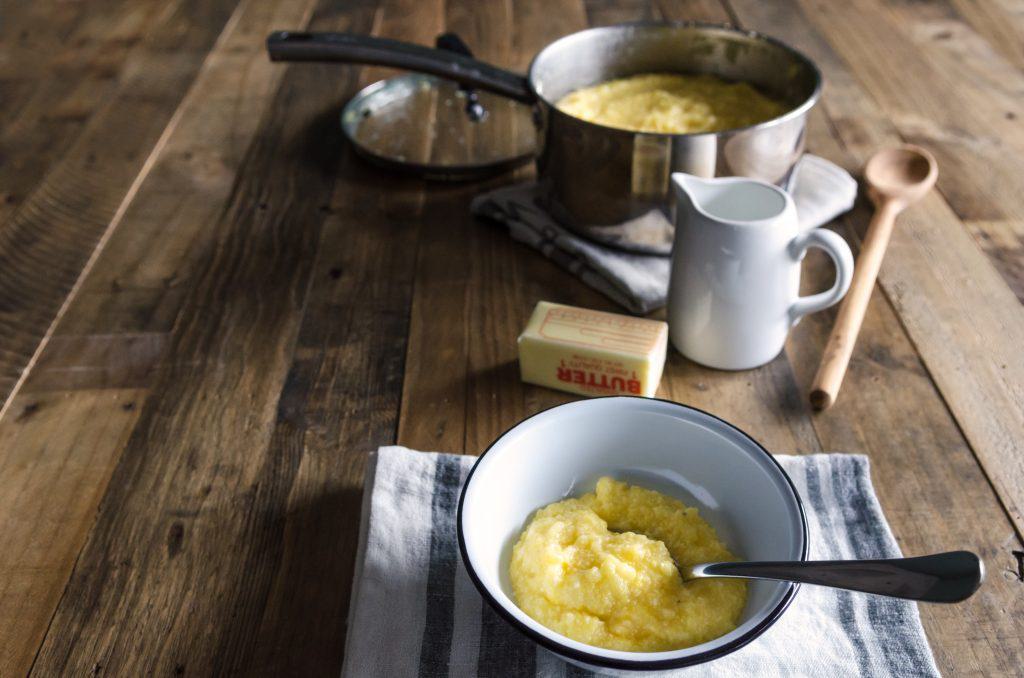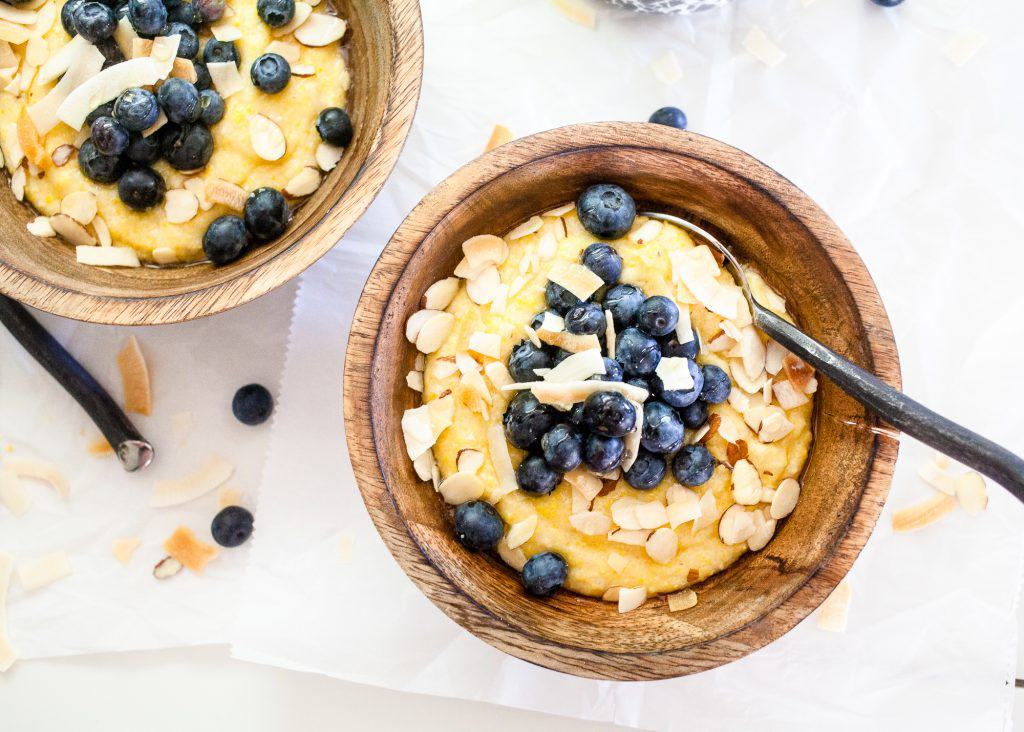Our corn grits are one of my favorite products we have here at Bobs Red Mill. They can be prepared quickly and simply but can also be adapted to fit any mealsavory or sweet! For todays What Is It Wednesday Im answering some of our frequently asked questions about grits and sharing my favorite recipes.
What are grits? Corn grits are made from dried milled corn that has had most of the germ removed. The germ of the corn kernel is the tiny bud or root of the kernel and is naturally higher in oils. Removing the germ creates the signature fluffy and light texture we love about grits!
We offer four types of corn gritsa conventional
Corn Grits/Polenta,
Organic Corn Grits/Polenta,
Gluten Free Corn Grits/Polenta, and a
White Corn Grits version. They can all be used interchangeably in recipes that call for grits.
Where are corn grits grown? All of our corn is grown in California.
[caption id="attachment_1161628" align="aligncenter" width="800"]

Traditional Grits from BobsRedMill.com[/caption]
How are grits made? At the farm the corn is dried while on the cob. Once sufficiently dried, the corn kernels are shucked from the cob and milled into a medium grind consistency. During the milling process the germ is broken off the kernel and separated by an aspirator. Because the germ is full of oil and therefore heavier, it falls to the bottom while the aspirator pulls up the lighter bits of corn. Most of the germ is removed during this process, but some still remains which is why we refer to our Corn Grits/Polenta as partially de-germed.
 Are grits gluten free?
Are grits gluten free? Yes, corn is a naturally gluten free product, however, it may come in cross contact with wheat during transportation and storage. We offer Gluten Free Corn Grits/Polenta, which are packaged in our dedicated gluten free facility and tested before, during, and after for the presence of gluten.
How do grits differ from cornmeal? The main difference between our cornmeal and our Corn Grits/Polenta is that our cornmeal is whole grain, nothing added and nothing removed, and our Corn Grits/Polenta are partially de-germed and not considered whole grain. When cooking them, the cornmeal will have a heavier, denser texture, while the Corn Grits/Polenta will have a light and fluffy texture.
Are grits the same thing as hominy? No, hominy and hominy grits are not the same as our Corn Grits/Polenta. Hominy is made from dried corn that has been soaked in an alkaline solution in a process called nixtamalization. During the process of nixtamalization the corn kernels are soaked and then dried. The whole soaked and dried corn is called hominy and the ground corn is called masa harina.
[caption id="attachment_1161630" align="aligncenter" width="801"]

Lemon Blueberry Grits from PioneerWoman.com[/caption]
What are the black/dark specks in my grits? The black/dark specks you see in your grits are the particles of germ that are left in the product. The germ of the corn kernel is naturally darker in color and it is absolutely normal to see grey/black/dark flecks throughout your corn grits.
How do I prepare grits? Grits can be prepared in a variety of ways. You can serve grits as a savory dish with cheese and butter, or as a hot cereal with milk and honey. You can also prepare the grits, allow them to cool, and then slice and fry in a hot pan for a crispy fried side dish. Yum!
If youre looking for some recipe inspiration take a look at the links below! You can use any of our Corn Grits/Polenta product interchangeably in your recipes.
[caption id="attachment_1161627" align="aligncenter" width="800"]

Cheesy Polenta Casserole with Gorgonzola - BobsRedMill.com[/caption]



 Traditional Grits from BobsRedMill.com[/caption]
How are grits made? At the farm the corn is dried while on the cob. Once sufficiently dried, the corn kernels are shucked from the cob and milled into a medium grind consistency. During the milling process the germ is broken off the kernel and separated by an aspirator. Because the germ is full of oil and therefore heavier, it falls to the bottom while the aspirator pulls up the lighter bits of corn. Most of the germ is removed during this process, but some still remains which is why we refer to our Corn Grits/Polenta as partially de-germed.
Traditional Grits from BobsRedMill.com[/caption]
How are grits made? At the farm the corn is dried while on the cob. Once sufficiently dried, the corn kernels are shucked from the cob and milled into a medium grind consistency. During the milling process the germ is broken off the kernel and separated by an aspirator. Because the germ is full of oil and therefore heavier, it falls to the bottom while the aspirator pulls up the lighter bits of corn. Most of the germ is removed during this process, but some still remains which is why we refer to our Corn Grits/Polenta as partially de-germed.
 Are grits gluten free? Yes, corn is a naturally gluten free product, however, it may come in cross contact with wheat during transportation and storage. We offer Gluten Free Corn Grits/Polenta, which are packaged in our dedicated gluten free facility and tested before, during, and after for the presence of gluten.
How do grits differ from cornmeal? The main difference between our cornmeal and our Corn Grits/Polenta is that our cornmeal is whole grain, nothing added and nothing removed, and our Corn Grits/Polenta are partially de-germed and not considered whole grain. When cooking them, the cornmeal will have a heavier, denser texture, while the Corn Grits/Polenta will have a light and fluffy texture.
Are grits the same thing as hominy? No, hominy and hominy grits are not the same as our Corn Grits/Polenta. Hominy is made from dried corn that has been soaked in an alkaline solution in a process called nixtamalization. During the process of nixtamalization the corn kernels are soaked and then dried. The whole soaked and dried corn is called hominy and the ground corn is called masa harina.
[caption id="attachment_1161630" align="aligncenter" width="801"]
Are grits gluten free? Yes, corn is a naturally gluten free product, however, it may come in cross contact with wheat during transportation and storage. We offer Gluten Free Corn Grits/Polenta, which are packaged in our dedicated gluten free facility and tested before, during, and after for the presence of gluten.
How do grits differ from cornmeal? The main difference between our cornmeal and our Corn Grits/Polenta is that our cornmeal is whole grain, nothing added and nothing removed, and our Corn Grits/Polenta are partially de-germed and not considered whole grain. When cooking them, the cornmeal will have a heavier, denser texture, while the Corn Grits/Polenta will have a light and fluffy texture.
Are grits the same thing as hominy? No, hominy and hominy grits are not the same as our Corn Grits/Polenta. Hominy is made from dried corn that has been soaked in an alkaline solution in a process called nixtamalization. During the process of nixtamalization the corn kernels are soaked and then dried. The whole soaked and dried corn is called hominy and the ground corn is called masa harina.
[caption id="attachment_1161630" align="aligncenter" width="801"] Lemon Blueberry Grits from PioneerWoman.com[/caption]
What are the black/dark specks in my grits? The black/dark specks you see in your grits are the particles of germ that are left in the product. The germ of the corn kernel is naturally darker in color and it is absolutely normal to see grey/black/dark flecks throughout your corn grits.
How do I prepare grits? Grits can be prepared in a variety of ways. You can serve grits as a savory dish with cheese and butter, or as a hot cereal with milk and honey. You can also prepare the grits, allow them to cool, and then slice and fry in a hot pan for a crispy fried side dish. Yum!
If youre looking for some recipe inspiration take a look at the links below! You can use any of our Corn Grits/Polenta product interchangeably in your recipes.
Lemon Blueberry Grits from PioneerWoman.com[/caption]
What are the black/dark specks in my grits? The black/dark specks you see in your grits are the particles of germ that are left in the product. The germ of the corn kernel is naturally darker in color and it is absolutely normal to see grey/black/dark flecks throughout your corn grits.
How do I prepare grits? Grits can be prepared in a variety of ways. You can serve grits as a savory dish with cheese and butter, or as a hot cereal with milk and honey. You can also prepare the grits, allow them to cool, and then slice and fry in a hot pan for a crispy fried side dish. Yum!
If youre looking for some recipe inspiration take a look at the links below! You can use any of our Corn Grits/Polenta product interchangeably in your recipes.
 Cheesy Polenta Casserole with Gorgonzola - BobsRedMill.com[/caption]
Cheesy Polenta Casserole with Gorgonzola - BobsRedMill.com[/caption]